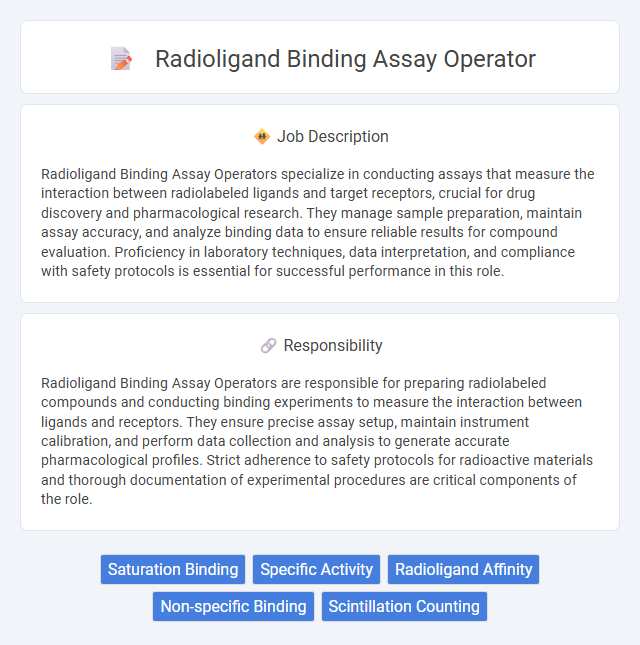
Radioligand Binding Assay Operators specialize in conducting assays that measure the interaction between radiolabeled ligands and target receptors, crucial for drug discovery and pharmacological research. They manage sample preparation, maintain assay accuracy, and analyze binding data to ensure reliable results for compound evaluation. Proficiency in laboratory techniques, data interpretation, and compliance with safety protocols is essential for successful performance in this role.
Individuals with strong attention to detail and steady hands are likely suitable for a Radioligand Binding Assay Operator position due to the precise nature of the work. Candidates who may experience difficulties with repetitive tasks or require a highly social environment might find this role less compatible. The job probably demands a comfortable tolerance for handling radioisotopes in a controlled lab setting, which could be unsuitable for those with sensitivity to such conditions.
Qualification
A Radioligand Binding Assay Operator must possess a degree in biochemistry, pharmacology, or a related life science field, along with hands-on experience in radioligand binding techniques. Proficiency in handling radioactive materials, understanding receptor-ligand interactions, and operating scintillation counters or gamma counters is essential. Strong knowledge of laboratory safety protocols, data analysis software, and regulatory compliance ensures accurate and reliable assay results.
Responsibility
Radioligand Binding Assay Operators are responsible for preparing radiolabeled compounds and conducting binding experiments to measure the interaction between ligands and receptors. They ensure precise assay setup, maintain instrument calibration, and perform data collection and analysis to generate accurate pharmacological profiles. Strict adherence to safety protocols for radioactive materials and thorough documentation of experimental procedures are critical components of the role.
Benefit
Radioligand Binding Assay Operators likely gain valuable experience in advanced biochemical techniques, enhancing their expertise in drug discovery and molecular pharmacology. This role probably offers exposure to state-of-the-art laboratory equipment and the chance to contribute to impactful research projects. Opportunities for career advancement and professional development may also be present due to the specialized nature of the work.
Challenge
Radioligand Binding Assay Operators likely face challenges related to maintaining precision and accuracy in complex laboratory procedures while handling radioactive materials. Ensuring consistent assay results may require meticulous attention to detail and strong problem-solving skills to troubleshoot unexpected variations. The role probably demands adherence to strict safety protocols and regulatory standards, increasing the operational complexity.
Career Advancement
Radioligand Binding Assay Operators gain specialized expertise in handling high-precision biochemical assays critical for drug discovery and receptor analysis. Mastery of radioligand techniques and data interpretation opens pathways to senior analytical roles, quality control management, or research scientist positions. Continuous skill development in assay optimization and regulatory compliance significantly enhances prospects for leadership within pharmaceutical and biotechnology sectors.
Key Terms
Saturation Binding
A Radioligand Binding Assay Operator specializes in performing saturation binding experiments to determine the affinity and number of receptor sites on biological samples. This role involves precise preparation of radiolabeled ligands, incubation with target receptors, and quantitative analysis of binding data to generate saturation curves. Mastery of techniques such as Scatchard plot analysis and non-specific binding controls is essential for accurate interpretation of receptor-ligand interactions.
Specific Activity
Radioligand Binding Assay Operators manage assays that measure receptor-ligand interactions, ensuring precise determination of the Specific Activity of radiolabeled compounds, a critical parameter reflecting radioactivity per unit mass. Accurate quantification of Specific Activity enables the assessment of ligand purity and binding efficiency essential for drug discovery and pharmacological research. Mastery of techniques such as scintillation counting and data analysis software is required to optimize assay sensitivity and reproducibility.
Radioligand Affinity
Radioligand Binding Assay Operators conduct precise measurements of radioligand affinity to target receptors, ensuring accurate quantification of binding kinetics and receptor-ligand interactions. They utilize specialized equipment to perform competitive and saturation binding assays, optimizing assay conditions for high specificity and reproducibility. Mastery of radiolabeled ligand handling, data acquisition, and analysis of binding curves is essential to support drug discovery and pharmacological research.
Non-specific Binding
Radioligand Binding Assay Operators specialize in conducting precise assays to measure the interaction between radiolabeled ligands and target receptors, critically focusing on minimizing non-specific binding to ensure data accuracy. Controlling non-specific binding involves optimizing assay conditions, such as buffer composition and washing protocols, to reduce background noise and enhance the specificity of ligand-receptor interactions. Expertise in interpreting binding curves and implementing strategies to differentiate specific from non-specific signals is essential for reliable pharmacological profiling and drug discovery.
Scintillation Counting
Radioligand Binding Assay Operators expertly perform Scintillation Counting to quantify radiolabeled compounds bound to cellular receptors, ensuring precise analysis of ligand-receptor interactions. Proficiency in handling liquid scintillation counters and optimizing counting efficiency is critical for generating reliable binding data in drug discovery. Maintaining stringent quality controls and calibrating instrumentation regularly enhances assay sensitivity and reproducibility in biochemical research.
 kuljobs.com
kuljobs.com